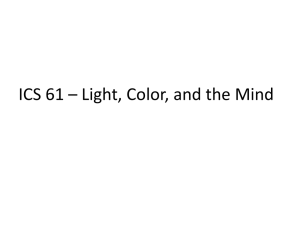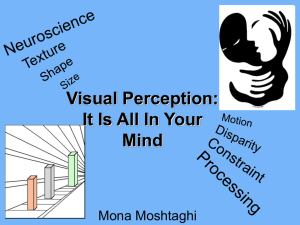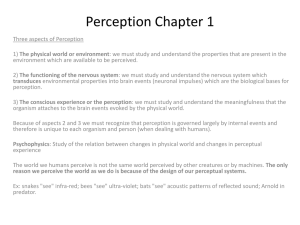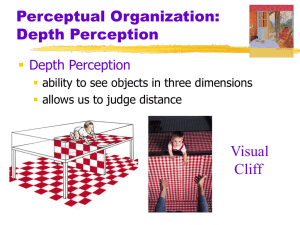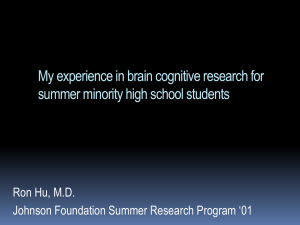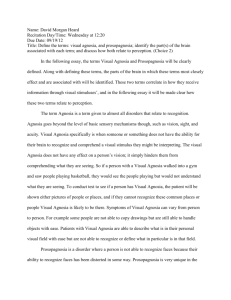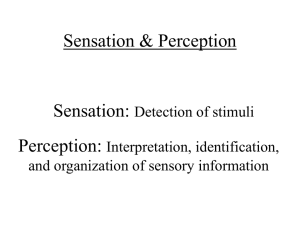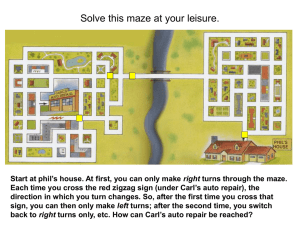visual perception-for
advertisement
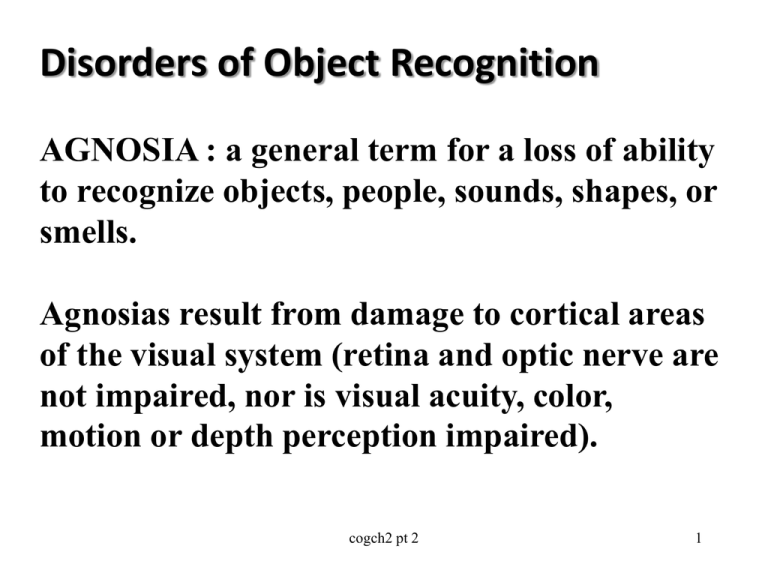
Disorders of Object Recognition AGNOSIA : a general term for a loss of ability to recognize objects, people, sounds, shapes, or smells. Agnosias result from damage to cortical areas of the visual system (retina and optic nerve are not impaired, nor is visual acuity, color, motion or depth perception impaired). cogch2 pt 2 1 DSM does not officially categorize agnosia however, they are commonly divided into two categories: Apperceive Agnosia and Associative Agnosia. cogch2 pt 2 2 Apperceptive Agnosias (Difficulty with perceptual processes) Have trouble recognizing, copying, or discriminating between different visual stimuli. Ex. may not be able to distinguish a poker chip from a scrabble tile despite their clear difference in shape and surface features. cogch2 pt 2 3 When patients are able to identify objects, they do so based on inferences using color, size, texture and/or reflective cues to piece it together. Video (begin @ .33) cogch2 pt 2 4 Simultanagnosia refers to an inability to recognize two or more things at the same time. cogch2 pt 2 5 - may have difficulty reading and counting because these activities involve viewing more than one thing at a time. - may seem to be "blind" since they bump into objects that are close together. Motion may further impair their ability to perceive objects. cogch2 pt 2 6 Associative agnosias - Perceptual processes are intact but patient is unable to recognize visually presented objects -may be able to replicate a drawing of the object but still fail to recognize it. cogch2 pt 2 7 Object Recognition Apperceptive Agnosia Associative Agnosia Integrating or Combing features Shape Processing cogch2 pt 2 8 Face Recognition Is it different than Object recognition? Yes. More Holisitc - altering the appearance of one facial region can strikingly affect the percept of other regions and of the whole face. Memory for a face is nore accurate cogch2 pt 2 9 Part-whole illusion. Part-whole illusion. The only difference between the two images is the mouth. Altering the mouth creates illusions of alteration in regions of the rest of the face (e.g., makes the nose appear shorter on left and longer on right, makes the eyes appear more interested on left and less interested on right). In the inverted version, the difference in the mouth shape can be easily seen but the illusory changes in the rest of the face are not apparent. cogch2 pt 2 10 Composite Face Illusion cogch2 pt 2 11 Prosopagnosia - failure to recognize faces Video described a woman who could not recognize her family’s faces or her own. She could recognize people through voices, hair color, eye color… cogch2 pt 2 12 Fusiform Face Area of temporal Lobe. source cogch2 pt 2 13 Bruce and Young (1986) model of face recognition. (1) Face detection followed by (2) processing of the face’s structure which is then matched to a memory representation (face memory). (3) The perceptual representation of the face can also be used for recognition of facial expression and gender discrimination. cogch2 pt 2 14 Evidence of separate processes • Edward: impaired face recognition but normal face detection. • Some Prosopagnosia patients cannot recognize faces but can recognize emotions. • Young et. Al (1985) diary study – Information about person before name recall. • Alexithymia - Emotion blindness cogch2 pt 2 15 Individual differences in Face Recognition Ability Developmental vs. Acquired Prosopagnosia Super-Recognizers Criminal Justice Application Want to test your own Face Recognition Ability? cogch2 pt 2 16 Visual Imagery and Visual Perception Visual Perception relies heavily on Bottom-up Processes. Visual Imagery is totally top-down. Confusions between Imagery and Perception Charles Bonnet Syndrome - form of phantom vision. cogch2 pt 2 17 Theories Visual Imagery resembles Visual Perception (Kosslyn). Where are Visual images formed in the brain? Primary Visual Cortex (V1 and V2) referred to as the visual buffer. These areas are active in both visual perception and visual imagery. cogch2 pt 2 18 Binocular rivalry occurs when different images are presented, one to each eye, observers do not perceive a blend of the two stimuli, but instead experience irregular perceptual alternations between the two images such that only one image is typically perceived at a time. cogch2 pt 2 Demo 19 If one image is presented slightly beforehand, it primes (increases the likelihood of) the perception of that image in the binocular rivalry situation. What happens when the prime is imagined rather that perceived? Same effect. Imagery can facilitate perception! cogch2 pt 2 20 Baddley and Andrade (2002) Participants rated the visual vividness of images under three different conditions. No other simultaneous task. – baseline. Auditory simultaneous task – same as baseline Visual simultaneous task – less vivid Perceptual and Imagery tasks interfere with each other. cogch2 pt 2 21 Brain Imaging Extensive overlap (~ 2/3rds) in areas used for visual perception and visual imagery. Visual Imagery involves only some of the processes involved in perception – more memory areas and less lower level processes. cogch2 pt 2 22 Disorders of Visual Imagery Damage to areas of the Left Temporal lobe (thought to store knowledge of objects) can cause impairment in ability to use imagery to accomplish a task (draw an object from memory) but does not interfere with perception. Anton’s Syndrome – Blindness denial! - cortical blindness (visual cortex destroyed) cogch2 pt 2 23 Mental Rotation Shepard & Metzler (1971) cogch2 pt 2 24 Found that the farther you have to rotate an object mentally, the longer the comparison takes. The speed at which you can complete the tasks provides a general measure of your spatial ability. -takes time to mentally rotate object -greater the rotation, longer the time cogch2 pt 2 25 Gender Differences in Mental Imagery Nature or Nurture?? Cross Cultural Studies Hunter Gatherer Theory Practice and Gender Differences cogch2 pt 2 26 Perception & Action Which Line appears Longer? Mϋller-Lyer Illusion Ponzo Illusion Two Visual Systems: Perception and Action Visual information for perception and for action are processed separately through independent streams. The ventral stream, projecting from the primary visual cortex to temporal lobe, processes information relevant for object recognition, while the dorsal stream, projecting from the primary visual cortex to the parietal lobe, processes information for action. (Goodale & Milner) Systems are Partially Independent. When we ask people which line is longer, they rely on the “Where” or “How” “What” system and they show dorsal stream evidence of the Illusion. “What” or ventral stream When you ask people to interact, (e.g. point) they use the “Where” system and the illusion is greatly reduced? Ames Window Illusion Action based performance Pointing or grasping reduces the illusion. Patient DF D.F. has a profound inability to recognize objects, places and people, in large part because of her inability to make perceptual discriminations of size, shape or orientation (agnosia), despite having good visual acuity. When DF is asked to reach for an object, she can do so well and she shows appropriate preshaping of her hand which scales correctly with the size of the object. This suggests she has intact visual perception-for-action. Figure 4.29 Performance of D.F. and a person without brain damage for two tasks: (a) judging the orientation of a slot; and (b) placing a card through the slot. See text for details. (From Milner & Goodale, 1995.) In sight But out of Mind Inattentional Blindness - This is only a test Video Experts? Factors Effecting Inattentional Blindness Gorilla more likely to be detected (83%) when counting black team throws than when counting white team throws. • Unattended object attracts more attention when it is similar to task-relevant stimuli. Change Blindness Inattentional Blindness Change Blindness The Door Study - Video Another example Change Blindness Stimuli cogch2 pt 2 36 • Type changes are more likely detected than token changes. • Less likely when viewer is forewarned there will be a change. • Detection more likely if the changed object received attention (fixated) before it changes. Why does Change Blindness Occur? Failure of Attention? We initially form detailed and complete representations but these representations fade (decay) quickly or are overwritten by subsequent stimulus. Change Blindness Blindness: optimistic belief about our ability to detect visual changes. Does Perception Require Conscious Awareness? Subliminal Perception Limen = subjective threshold. Subjective vs. Objective threshold Subliminal Perception: occurs when a stimulus is too weak to be perceived yet a person is influenced by it. Subliminal Perception Naccache et al. (2002) Task: Decide as quickly as possible if the letter presented is larger or smaller than 5. Masked (Subliminal) Prime preceded the visible presentation. Participants reported no conscious perception of the prime. However, their performance on the task indicated that they were effected by the subliminal prime. Congruent condition - both prime and visible digit produce same answer. Incongruent condition - prime and visible digit produce different answer. The incongruent prime condition slower than congruent. fMRI pictures of houses or faces either at objective threshold or clearly visible: Both conscious and unconscious faces activated Right fusiform area (to some degree); conscious words led to more extensive brain activity, including the prefrontal cortex. 90% could be accurately identified as houses or faces . How Long Does the Objective Effect Last Lexical Priming Procedure Stimulus flashed for a split second then quickly masked with another stimulus. e.g. Doctor Then a target stimuli is shown either an unrelated word (e.g., bread), a related word (e.g. nurse) or a letter string (djotr). Lexical Decision Task – (is target a word?) If the priming stimulus bears a close relationship to the target word, the subject can respond slightly faster. This is a subliminal effect, because the priming stimulus cannot be seen consciously, and subjects cannot report what it is. However, the effect lasts only a tenth of a second (Greenwald, Draine, & Abrams, 1996). Mindsight People can detect THAT a change is happening, but can’t consciously identify WHAT is changing. Blind Sight Video - begin at 15:40
